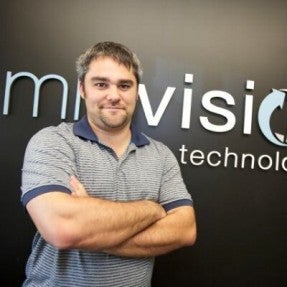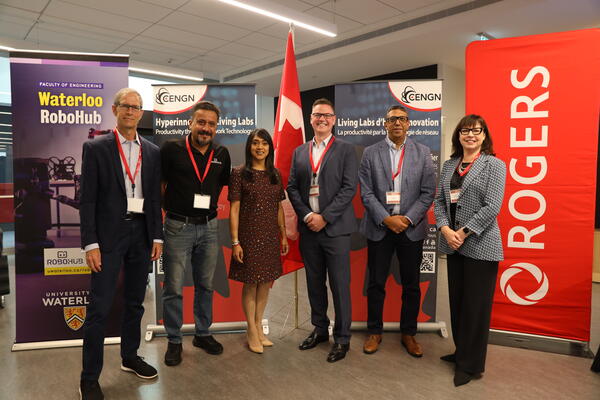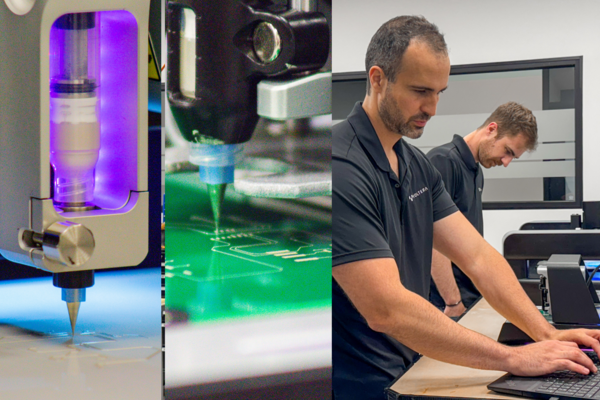
How Miovision is moving us closer to ending road rage
A combination of hardware and software to analyze traffic conditions in real time, then adjust traffic lights to improve the flow of vehicles

A combination of hardware and software to analyze traffic conditions in real time, then adjust traffic lights to improve the flow of vehicles
By Shane Schick Faculty of EngineeringWhen people started putting mannequins in the backs of their cars to try and sneak onto HOV lanes during the Pan Am Games in Toronto, it was an extreme example of how desperate we can become when faced with major traffic congestion. It was also proof that Miovision’s potential solution to transportation management couldn’t come at a better time.
 Co-founded by University of Waterloo Engineering alum Kurtis McBride, Miovision uses a combination of hardware and software to analyze traffic conditions in real time, then adjust traffic lights to improve the flow of vehicles. After raising $30 million in funding earlier this year, the company’s growth may seemed to have happened overnight, but McBride says his entrepreneurial ambitions started early.
Co-founded by University of Waterloo Engineering alum Kurtis McBride, Miovision uses a combination of hardware and software to analyze traffic conditions in real time, then adjust traffic lights to improve the flow of vehicles. After raising $30 million in funding earlier this year, the company’s growth may seemed to have happened overnight, but McBride says his entrepreneurial ambitions started early.
“I’ve always had the interest in starting a business, much to my parent’s dismay,” he says, recalling an early attempt to raise mice for sale in his family’s basement as a child. At Waterloo, McBride studied Systems Design Engineering, which he described as an area with plenty of room to explore opportunities. “The program really incubated that bug that I’d always had.”
In one of McBride’s engineering co-op jobs, for example, he worked in software development with a transportation company. The firm was often short-staffed and needed some “front-line” help with collecting data.
“They would pull me in on weekends, and I would sit on a lawn chair and count the cars that went by,” he says. “I started to see a market need through that experience.”
 The first generation of Miovision’s product was really focused on providing data to help city planners make better decisions about transportation management. More recently, it has launched a product which is being permanently installed at intersections to better understand how the network is performing, and to improve that performance accordingly. This kind of technology is becoming of increased interest to local governments who see traffic management as a foundational element of “smart city” initiatives, as well as those touting the benefits of connectivity via the “Internet of Things.
The first generation of Miovision’s product was really focused on providing data to help city planners make better decisions about transportation management. More recently, it has launched a product which is being permanently installed at intersections to better understand how the network is performing, and to improve that performance accordingly. This kind of technology is becoming of increased interest to local governments who see traffic management as a foundational element of “smart city” initiatives, as well as those touting the benefits of connectivity via the “Internet of Things.
“On one level, our data collection product has something like 50 percent market share in North America, and we’re a mature company that’s been around for five or six years,” he says. “But there’s also still very much a startup side to who we are. I guess the difference is that the first time you do a startup, you’re really learning as you go. Now we’re in a spot where we have the means to do it right, and to take the time to keep it right.”
Keeping it right means focusing on creating a strong culture inside Miovision, McBride adds. The company has taken the Agile methodology used in creating more rapid, collaborative iterations of software applications and applied it across the board. This includes, operations, finance and marketing.
“The punchline of our culture is empowerment,” he says. “The notion is that if we trust people who are close to the customer and close to the front lines, they will do the right things.”
In other words, just as Miovision is helping clear up conditions on the road, it’s not about to put up any internal roadblocks to innovation.

Read more
Living Lab initiative will help Canadian companies test and validate products and services at Waterloo’s RoboHub

Read more
Voltera prints electronics making prototyping faster and more affordable — accelerating research to market-ready solutions

Read more
New funding accelerates the deployment of Cobionix’s medical robotics platform across North America and the UK
Read
Engineering stories
Visit
Waterloo Engineering home
Contact
Waterloo Engineering
The University of Waterloo acknowledges that much of our work takes place on the traditional territory of the Neutral, Anishinaabeg, and Haudenosaunee peoples. Our main campus is situated on the Haldimand Tract, the land granted to the Six Nations that includes six miles on each side of the Grand River. Our active work toward reconciliation takes place across our campuses through research, learning, teaching, and community building, and is co-ordinated within the Office of Indigenous Relations.